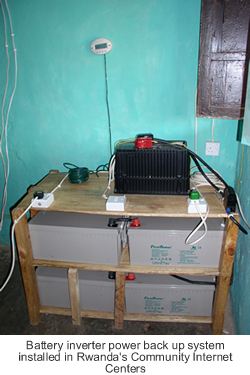 |
||
|
|
DOT-COM HOME https://dot-com-alliance.org/index.htm
Contact Us https://dot-com-alliance.org/contact.htm |
|
|||
|
|||
|
Rwanda: The Power to Succeed Imagine this scenario Local entrepreneurs devote their heart, soul and hard-earned money to establishing telecenter businesses in remote towns as their recovering country pulls together to rebuild itself. One day theres a power outage that shuts down all the computers in the telecenters for several hours. The next day, theres another power outage lasting for several hours. This pattern continues for weeks and months as the countrys electricity grid fails to keep up with growing nationwide demand. Telecenter revenues zig zag from month to month, depending on how many hours the power supply is available. The ability of the telecenters to survive is put in doubt. The reality faced by Rwanda's Community Internet Centers Unfortunately, this scenario is not hypothetical. It reflects the experience of two entrepreneur- owned Community Internet Centers (CICs) in Rwanda, which were established in April 2003 with assistance from dot-ORG (See previous articles listed at the bottom of this page). The CICs are located in the towns of Gitarama and Nyanza, a few hours away from the capital, Kigali. By late 2003, power outages were beginning to have serious impacts on their revenue streams. Gross monthly revenue at the CIC in Gitarama fell from $715 in November 2003 to $252 in January 2004. The CIC in Nyanza experienced revenue declines of similar proportions. Partners called upon to find a solution dot-ORG turned to one of its core resource partners, Winrock International, and Winrocks Kenyan partner, Energy Services Development Africa (ESDA), to come up with a backup power solution that would enable the two telecenters to provide services all day, thereby returning their full revenue potential. In addition, dot-ORG asked for a third back-up power system along with guidance on ways to reduce power consumption for a new CIC planned for the town of Nyamata. Establishing a reliable power supply with a battery backup power system Winrock and ESDA selected a backup power system that uses deep-cycle, maintenance-free batteries to store energy from the electricity grid or a generator. When the daily power outages occur, the stored energy is used to power the core telecenter equipment. Winrocks analysis showed that this solution would cost much less over a three-year period than a used diesel generator without battery storage, due to the high recurring costs of buying fuel for the latter option. Because the telecenters are located in towns where inexpensive grid electricity is generally available for some time each day, renewable energy options such as solar photovoltaics were not cost competitive. The backup power systems were installed in each CIC in September 2004, at a total cost per system of $5,438 including equipment, installation and training of CIC staff members in operation and maintenance. As a USAID-sponsored program, dot-ORG was exempt from paying duties and VAT on equipment.  Click on the photo for details. Click on the photo for details.Matching low-power consumption hardware with power backup systems Each battery/inverter backup power system was sized to a capacity of 800 amp-hours (Ah). This is sufficient to run the core equipment in the Gitarama and Nyanza CICs for a period of seven consecutive hours. The core equipment in each center consists of ten desktop computers, ten CRT monitors, one inkjet printer and three fluorescent lights. Based on Winrocks recommendation, the newly established CIC in Nyamata opted to reduce its total power consumption by purchasing low- power LCD monitors instead of CRT monitors. The low-power configuration will enable the new CIC to operate for more than 13 consecutive hours using the same size battery system as the other telecenters. Early Results A few days after the installation of the backup power systems, the telecenters were already experiencing higher than usual customer turnout as a result of a combination of factors:
All three factors are significantly improving the image of the telecenters in the eyes of their customers. The energy-related investment are giving all three telecenters a clear advantage over the competition. Some challenges remain, however. Worsening grid power outages, lasting up to two days, mean that the telecenters cannot always recharge their batteries on a daily basis. Additional follow up will be necessary to address these challenges before on can truly assess the impact of the power backup solutions installed in the CICs. Replication Potential The battery-inverter power backup solutions designed for this project may be appropriate for other telecenters of similar size (about 10 computers) with limited access to AC electricity from a grid or other source. Battery-inverter backup power systems are more likely to present a competitive option when the following conditions exist:
|

|
|||||||||||